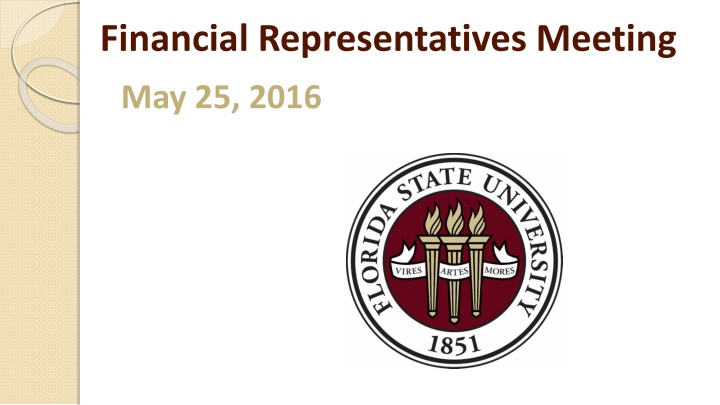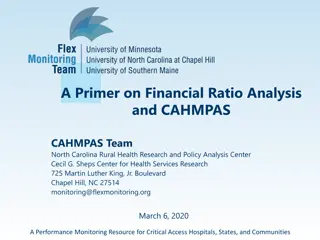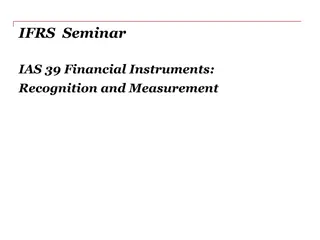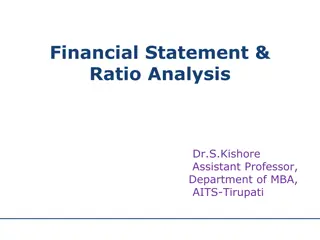
Financial Representatives Meeting - May 25, 2016 Agenda and FSU Vehicle Management Program Overview
The Financial Representatives Meeting on May 25, 2016 discussed various topics including facilities, business services, and vehicle management at FSU. The FSU Vehicle Management Program (FVMP) aims to centralize vehicle-related processes and ensure maintenance and safety standards are met for university-owned vehicles.
Download Presentation

Please find below an Image/Link to download the presentation.
The content on the website is provided AS IS for your information and personal use only. It may not be sold, licensed, or shared on other websites without obtaining consent from the author. If you encounter any issues during the download, it is possible that the publisher has removed the file from their server.
You are allowed to download the files provided on this website for personal or commercial use, subject to the condition that they are used lawfully. All files are the property of their respective owners.
The content on the website is provided AS IS for your information and personal use only. It may not be sold, licensed, or shared on other websites without obtaining consent from the author.
E N D
Presentation Transcript
Financial Representatives Meeting May 25, 2016
Agenda Introduction Facilities Student Business Services Accounting & Property Services Budget Office Procurement Services Disbursement Services Closing
FSU Vehicle Management Program (FVMP) Dennis Bailey, Sr. Associate Vice President Facilities
FSU Vehicle Management Program (FVMP) Created to establish a centralized repository of all processes and documentation relating to the management of University vehicles. It is not the intent to create a centralized fleet program. Each area Vice President is responsible for compliance with the Vehicle Management Plan within their area of responsibility
FSU Vehicle Management Program (FVMP) Maintenance and safety inspections of FSU-owned vehicles University owned vehicles must be maintained in a timely manner Records of vehicle maintenance and repairs must be tracked and kept in FSU Facilities Integrated Workplace Management System, AiM Preventative maintenance tickets will be generated for each vehicle and must be addressed by departments AiM will also track and notify property custodians of recall notices and violations
FSU Vehicle Management Program (FVMP) Transfers/Surplus of FSU Vehicles The program will also ensure that vehicles being transferred between departments or sourced from FSU Surplus are in sound mechanical condition Driver s License Verification The policy will require that each department have a documented process in place to ensure that all employees that drive FSU owned vehicles have a valid driver s license Go-live July 1, 2016
Contact Information Questions? Fredrick Ross Procurement Specialist fross@fsu.edu 645-0407
Student Business Services Accounts Receivables and Collections Update
Reorganization of both AR and Collections Collections Accounts Receivables Ashley Wilmot Assistant Director Derek Blauer Assistant Director Ashley Jones Collections Manager Alisha Estep Payroll Deductions, Bankruptcy, and Returned Checks Garrett Ostberg Student Financial Specialist Derek Hall Charge Input Management Kevin Culligan Federal Perkins Loans Andi Spivey AR Reconciliations TBD Student Financial Specialist
AR vs Collections Whats the difference? Collections AR Charge Coordination Payment Arrangements Internal Collections Interfaces/Posting Charges External Collections Coordination Charge Reversals Payment Plans Billing/Invoicing
Change in Policy on Student Receivables Registration Stops Previous Policy Students held from registering for classes for owing $.01. Current Policy Students no longer held from registering for classes who owe less than $500.
Positive Outcomes Administrative Burden: Dealing with walk-ins, calls, etc. related to financial holds is one of the largest administrative burdens SBS faces. Refining this process has resulted in the reallocation of resources and assisted in the fulfilling the need for business analysts. Increased Revenue: The large majority of these students qualify for additional financial aid, which has in-turn generated additional tuition revenue, but has also paid off other charges. An argument that we ve long made is that a student who enrolls is FAR more likely to pay than one who hasn t. Cutting ties with a student, or denying persistence, is the worst thing we can do from a collections perspective.
Contact Information Questions? John Bembry jbembry@fsu.edu 644-9457
Auxiliary AR/Billings Project Judd Enfinger, Associate Controller Cassandra Rayne Gross, Sr. Auxiliary Accounting Specialist May 25, 2016
Agenda Background Changes Affecting You Process Overview Q&A
Scope Overview Anticipated go-live date: Early Fiscal Year 2017 OBS Lines of Business Postal, Copy, Parking & Transportation, etc ITS lines of business coming next Software Licensing, Desktop Support, Telecom, etc AR/Billing Functions Non-Student, Non-Sponsored Design will allow for future roll-out to additional auxiliaries See pages 2-3
Goals & Objectives: The Problem Auxiliaries use shadow systems to maintain customers, create invoices, and capture internal/external billing and accounts receivable transactions Financial transactions are then interfaced or manually re-entered into OMNI See page 2
Goals & Objectives: The Problem Duplicated effort Cost of supporting shadow systems (personnel, financial, time) Lack of transparency Compromised internal controls (audit risk) Inability for buying departments to account for their internal purchase commitments in our ERP system SRS unable to pre-approve auxiliary charges to sponsored projects (audit risk) Interdepartmental Requisition (IDR) process is cumbersome to departments Inconsistent billing and AR procedures Customer service gaps and inconsistency Burden on Student Central and SBS Team for non-student activity Decentralized check processing creates possibility of loss risk, deposit delay/cash flow timing inefficiencies
Goals & Objectives The overall goal of this project is to develop the capacity to improve and streamline billing and accounts receivable activity across all auxiliaries at FSU.
Benefits Enable our pilot auxiliaries to move AR/Billing activity into OMNI Enable internal encumbrances for two of our larger auxiliaries Create an alternative to Student Central for non-student AR Permit Sponsored Research Pre-Approval Short Term Reduce IDR processing Reduction in cash collection sites and check processing Enhanced Customer Service Eliminate Internal Check Processing Medium Term Strengthen internal controls, security and oversight Standardize billing/AR procedures Encumbrances for all internal purchases Eliminate IDR s Complete transition of non-student AR out of Student Central Long Term See page 2
PO Requirement for Internal Purchases The solution will require Purchase Orders to originate charges and encumbrances for all interdepartmental billing when the selling department is using AR/Billing when the selling department is using AR/Billing functionality in OMNI/PeopleSoft, functionality in OMNI/PeopleSoft, without exception.
Requiring POs for Internal AR/Billing Benefits Uses delivered functionality Uses delivered online workflow, including Sponsored Research pre-approval Improves transparency Reduces budget errors Eliminates need for manual IDR form processing
Differences from External Procurement Autosourcing: skips buyer No receiving on these internal PO s Open-Ended PO s are more common Who to contact For questions, change orders, etc. related to internal PO s, contact Auxiliary Accounting (not Procurement)
EXPECT MORE COMMUNICATION SOON ABOUT THE GO-LIVE DATE Including specific information about how to enter your requisitions
Example Internal PO & Encumbrance How to determine your requisition amount Example: Requisition Entry (Postal Services) Reconciliation Backup Receiving Invoices
Example Internal PO & Encumbrance How to Determine Requisition Amounts: Determine amount spent last year for the same duration of time Adjust estimates to reflect what you think you will spend this year By expense account and by supplier (selling auxiliary) Map to purchasing categories Determine how you want to set up your PO Each supplier must have a different PO (just like now) Each PO can include multiple lines (different expense accounts, different department/fund/project/CF combinations) Additional information and resources to help departments perform this analysis are in development.
Example Internal PO & Encumbrance: Requisition Navigate to page: http://my.fsu.edu > FI > Main Menu > eProcurement > Requisitions
Example Internal PO & Encumbrance: Requisition: Postal Services You will land on the Requisition Settings page. Click the magnifying glass to the right of the Supplier field to look up your supplier.
Example Internal PO & Encumbrance: Requisition: Postal Services Search for your supplier. All internal suppliers will begin with AUX. To find internal suppliers, type AUX in the Supplier ID field and hit FIND.
Example Internal PO & Encumbrance: Requisition: Postal Services The search results will show a list of internal suppliers. Select the appropriate supplier.
Example Internal PO & Encumbrance: Requisition: Postal Services The system will bring you back to the Requisition Settings page with the supplier information included.
Example Internal PO & Encumbrance: Requisition: Postal Services Search for your Category Code Select the magnifying glass next to the Category field.
Example Internal PO & Encumbrance: Requisition: Postal Services SelectCategory Code Type AUX into the Category field, and select the appropriate code.
Example Internal PO & Encumbrance: Requisition: Postal Services ChooseUnit of Measure. For internal requisitions, choose EA Enter a Due Date (for year-long open-ended PO s, use 6/30)
Example Internal PO & Encumbrance: Requisition: Postal Services
Example Internal PO & Encumbrance: Requisition: Postal Services Enter the item description Enter Price & Quantity: Price: $1.00 Quantity: equal to the amount you plan to spend for the PO duration
Example Internal PO & Encumbrance: Requisition: Postal Services
Example Internal PO & Encumbrance: Requisition: Postal Services To make changes to accounting/ chartfield information:
Example Internal PO & Encumbrance: Requisition: Postal Services Expand to view accounting lines and adjust the department, fund, project, and/or optional chartfield as needed.
Example Internal PO & Encumbrance: Requisition: Postal Services When reviewed and ready to submit for approval:
Example Internal PO & Encumbrance: Requisition: Postal Services
Example Internal PO & Encumbrance: Receiving invoices
Example Internal PO & Encumbrance: Receiving invoices
Internal PO & Encumbrance Reconciliation & Data Review Query FSU_DPT_VCHR_WITH_PYMT_JRNL Others BI Reports Expense Data Mining filtered by vendor or any other criteria desired Invoice Sample Data:
Things to know SRS approval Workflow is the same for internal/external PO s Change Orders: Use same form, but route differently: Internal: ctl-auxiliaryaccounting@fsu.edu External: changeorder@admin.fsu.edu Auxiliary Accounting handles questions related to internal requisitions and PO s Internal PO Work Sessions to be announced
Fund Reclassifications/Expansion Designated Funds Designated Entity that administers funds collected or set aside for a specific purpose, including certain student fees. 301 Student Fees - Student fees authorized by the Board of Trustees and not otherwise accounted for in the Student Fee Trust Fund or other specific Fund Code Includes fees for class materials & supplies, facility/equipment use, and distance learning Excludes tuition and application fees (Fund 120), transportation access (360), housing (370), health (390), activities & services (610), technology (615), athletics (630) 335 Central Operations & Services - Central offices and administrative departments that receive revenues from miscellaneous transfers and sources Excludes Auxiliary Overhead (Fund 330) Examples include web convenience fees (Dept 032300) and EH&S Fire Fund Insurance (Dept 024007)
Fund Reclassifications/Expansion Why? The University has identified the need to clearly distinguish between auxiliary enterprises and designated fund operations. Fund 320 will be used only to capture the activities of true auxiliary enterprises (business operations providing goods/services to faculty, staff, students, and incidentally the public) Changes designed to allow more consistent classification of these activities, and will facilitate clearer communication of expenditure guidelines and other rules and procedures.
Fund Reclassifications/Expansion What does this mean for you? Budget Managers with department(s) affected were contacted in January NOTE: An overall analysis of all Auxiliaries was conducted as part of this project and this resulted in some additional reclassifications (e.g. 610 to 320). The transition to the new Fund Codes will be handled centrally FY17 budgets Appointments Balance reclassifications Etc. No impact on Auxiliary Overhead or Expenditure Guidelines Transactions will need to be coded to new Dept/Fund combinations beginning in July 2016 Outstanding AR balances in Campus Solutions at 6/30/2016 WILL NOT be reclassified to the new Dept/Fund combinations Cash will be moved to new Dept/Fund periodically as collections are made
Fund Reclassifications/Expansion Construction Funds Additional Construction Funds were created within the last year or so (for departmental-funded construction) 801 E&G-funded Construction 802 Carryforward-funded Construction 826 Auxiliary-funded Construction 851 C&G Non-Federal-funded Construction 852 C&G Federal-funded Construction 861 Student Activities-funded Construction By utilizing these funds Construction Accounting is able to transfer departmental funding of construction projects to 8xx fund without changing the DeptID This means that budget should be entered for anticipated departmental- funded construction spending (using 780120 / Budget Account 780140) Departmental-funded construction can be monitored using the BI Construction Ledger dashboard report






















